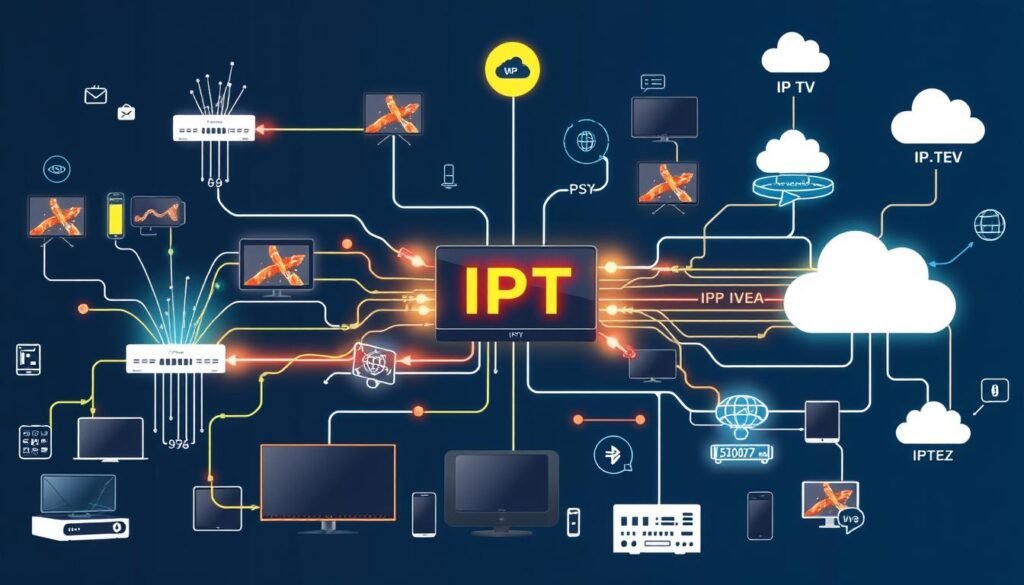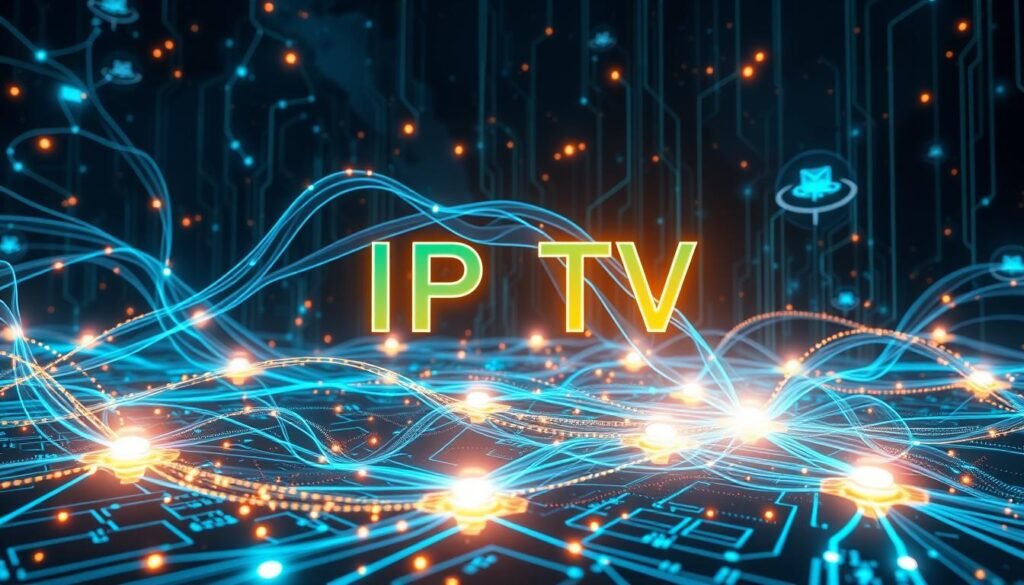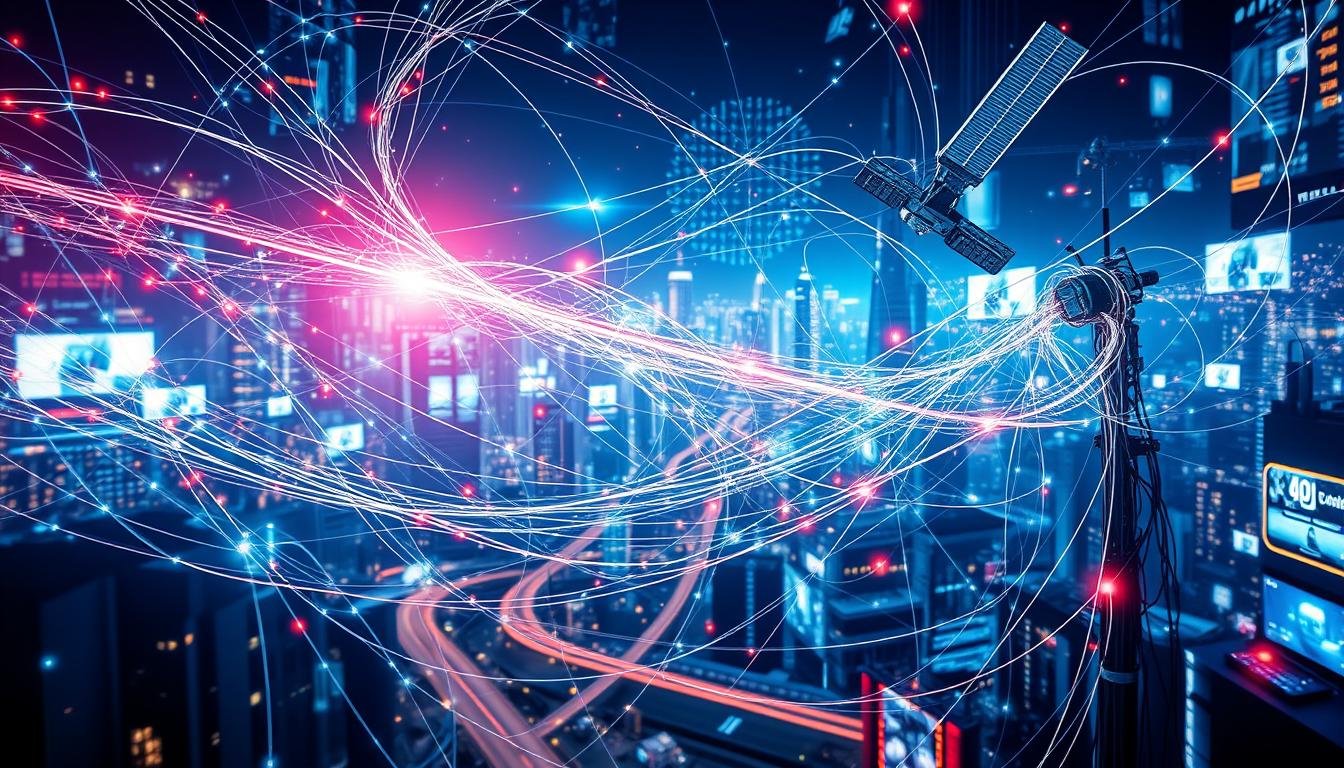In today’s digital world, how we watch TV has changed a lot. IPTV, or Internet Protocol Television, is a new way to watch high-quality video and audio over the internet. IPTV protocols are key to making sure streaming is smooth and the viewing experience is great for people all over.
IPTV protocols are like rules for sending and receiving TV signals over the internet. They help manage the complex task of sending multimedia content. This includes handling data packets, ensuring quality, and adding interactive features. Knowing how IPTV protocols work helps us understand this fast-changing technology.
Key Takeaways
- IPTV protocols are the foundational standards that enable the delivery of television content over IP networks.
- These protocols handle the intricate process of transmitting and receiving multimedia data, ensuring seamless streaming and exceptional quality.
- IPTV protocols are crucial for managing data packets, maintaining QoS, and enabling interactive features that enhance the viewer experience.
- Understanding IPTV protocols is essential for comprehending the technological advancements driving the transformation of the television industry.
- Mastering IPTV protocols is crucial for service providers, content creators, and industry professionals to stay ahead in the rapidly evolving digital media landscape.
Introduction to IPTV Protocols
In the world of content delivery, IPTV, or Internet Protocol television, is a big change. It uses the Internet to send TV and video, unlike old TV ways. At its core, IPTV works thanks to special protocols that make sure content gets to you smoothly.
What is IPTV?
IPTV sends TV and video over the Internet, not like old cable or satellite TV. It lets you watch what you want, when you want, making TV better for today’s viewers.
Importance of IPTV Protocols
For IPTV to work well, it needs good protocols. Internet Group Management Protocol (IGMP) and Real-Time Transport Protocol (RTP) are key. They help send audio and video right, keep everything in sync, and make sure lots of people can watch at once.
Common Uses of IPTV
IPTV is used in many places, like:
- Home entertainment, for a better TV experience
- Business, for training and company messages
- Schools, for online learning and interactive classes
- Healthcare, for watching patients from afar
IPTV is great because it’s flexible and powerful. It’s why so many people and companies use it.
As we want more custom and interactive content, IPTV’s role is more important. Knowing how IPTV works helps us see how tech is changing how we watch and interact with media.
“IPTV protocols are the backbone of a technology that is revolutionising the way we experience television and video content.”
Types of IPTV Protocols
IPTV, or Internet Protocol Television, uses various protocols for content delivery. These protocols are divided into three main types: streaming, control, and transport. Knowing how each type works is key to understanding IPTV systems.
Streaming Protocols
Streaming protocols, like the Real-Time Streaming Protocol (RTSP), are crucial for IPTV. They ensure audio and video content is delivered smoothly. This gives users a top-notch viewing experience.
Control Protocols
Control protocols, shown by the Session Initiation Protocol (SIP), manage user interactions. They handle tasks like user login, session setup, and call management. This makes user interaction with IPTV services seamless.
Transport Protocols
Transport protocols, including UDP and TCP, handle data packet transmission. They make sure IPTV content is delivered reliably and efficiently. This meets the fast delivery needs of streaming media.
| Protocol Type | Examples | Primary Functions |
|---|---|---|
| Streaming Protocols | RTSP | Manage the continuous delivery of audio and video content |
| Control Protocols | SIP | Handle user authentication, session establishment, and call control |
| Transport Protocols | UDP, TCP | Ensure the reliable and efficient delivery of IPTV content |
Understanding IPTV protocols helps organisations provide a smooth IPTV experience. This makes IPTV more engaging for users.
How IPTV Works
IPTV is all about sending data packets smoothly. It uses Internet Group Management Protocol (IGMP) and Multicast Listener Discovery (MLD) to do this. These protocols are key to making IPTV work well.
The Role of Data Packets
IPTV needs data packets to work right. These packets carry video and audio in a compressed form. They travel over the Internet using IP networks.
The IGMP protocol helps manage these packets. It lets viewers join and leave channels easily. This means only the right data gets to each viewer.
IPTV Delivery Mechanism
The way IPTV delivers content is complex. It uses MLD for IPv6 networks, just like IGMP for IPv4. These protocols work together to spread out content well.
This helps avoid network jams and makes the most of bandwidth. It’s all about keeping the viewing experience smooth.
| Protocol | Function |
|---|---|
| IGMP | Manages multicast groups in IPv4 networks, allowing clients to join and leave channels dynamically. |
| MLD | Performs a similar function to IGMP, but in IPv6 networks, enabling multicast group management. |
Thanks to these advanced protocols, IPTV gives a great viewing experience. It makes sure content is shared well across the network.

Key Features of IPTV Protocols
The digital world is always changing, and UDP and HTTP are key in IPTV. They make watching TV better for everyone. These features meet the needs of today’s TV viewers.
Scalability
IPTV protocols can grow with more users. UDP and HTTP handle more traffic well. This means IPTV can serve more people without losing quality.
Quality of Service (QoS)
Good quality TV watching is important. UDP and HTTP help by making sure video and audio get to you fast. This means you get a smooth viewing experience.
Interactivity
UDP and HTTP make TV watching interactive. You can watch what you want, get shows you like, and interact in real time. This lets you control your TV experience.
UDP and HTTP are key to the future of TV. They offer growth, quality, and interaction. These features meet the changing needs of today’s viewers.
Comparison with Traditional Broadcasting
The way we watch media is changing fast. IPTV is now compared to old methods like satellite and cable TV. We see how IPTV’s unique features stand out in today’s digital world.
IPTV vs. Satellite TV
Satellite TV was once the top choice, but IPTV is gaining ground. IP Multicast makes IPTV better by sending content more efficiently. This means more shows and a better viewing experience for everyone.
IPTV works over the internet, so you can watch it on many devices. This includes phones and smart TVs, making it very accessible.
IPTV vs. Cable TV
IPTV protocols beat cable TV in many ways. IPTV is based on IP, which means it can offer cool features like on-demand shows. You can also pause live TV and enjoy other digital services easily.
IPTV is also cheaper and can grow with demand. This makes it great for both providers and viewers. It could lead to more affordable and tailored TV experiences.
Looking at IPTV and old TV methods shows IPTV’s big potential. It’s set to change how we watch TV and videos. With IPTV, we’re moving towards more personal and interactive viewing.
Advantages of IPTV Protocols
IPTV protocols, like RTP and RTSP, bring many benefits. They make IPTV a top choice for delivering content. These benefits include flexibility, cost savings, and more viewing options for everyone.
Flexibility in Content Delivery
RTP and RTSP make content delivery flexible. They allow for smooth streaming of live and on-demand shows. This means viewers can watch what they want, when they want.
Content providers can offer a more tailored experience. They can meet the varied tastes of their audience better.
Cost-Effectiveness
IPTV is cheaper than old-school broadcasting. It uses existing networks and less expensive hardware. This makes it easier for both small and big content providers to start.
For viewers, this means cheaper access to more shows. It opens up a world of entertainment without breaking the bank.
Increased Viewing Options
IPTV lets viewers watch on many devices. From TVs and set-top boxes to phones and tablets. This gives viewers the freedom to watch anywhere, anytime.
This flexibility has made watching TV more exciting. It offers a diverse and engaging experience for everyone.
In summary, IPTV protocols offer flexibility, cost savings, and more viewing choices. They are a great choice for both providers and viewers. As technology advances, these protocols will keep shaping the future of TV and video.

Challenges in IPTV Implementation
IPTV is becoming more popular, but it faces several challenges. Two main issues are the need for a strong network and enough bandwidth.
Network Infrastructure Requirements
Setting up IPTV needs a solid network. The Session Initiation Protocol (SIP) is key for communication between the server and devices. It ensures smooth video and interaction, but it demands a lot from the network.
Bandwidth Limitations
Getting enough bandwidth for high-quality video is a big challenge. The Internet Group Management Protocol (IGMP) helps use network resources well. But, in places with poor broadband, it’s hard to scale IPTV services.
To solve these problems, we need to improve our networks and use bandwidth wisely. We also need better video compression. This way, IPTV can offer a great viewing experience to its users.
“The success of IPTV lies in the ability to provide a reliable, high-quality viewing experience that meets the evolving demands of modern audiences.”
Future of IPTV Protocols
The world of Internet Protocol Television (IPTV) is set for exciting changes. New technologies will make watching TV more immersive and personal. They will meet the changing tastes of today’s viewers.
Embracing Emerging Technologies
New technologies are changing IPTV for the better. Multicast Listener Discovery (MLD) and User Datagram Protocol (UDP) are being improved. They will help stream content smoothly and make networks more efficient.
As people want more high-quality, on-demand shows, these updates are key. They will help both viewers and service providers.
Predictions for Market Growth
IPTV is expected to grow a lot in the future. More people are using the internet for entertainment. This means more demand for IPTV, leading to market growth.
OTT services are also becoming more popular. They offer lots of content on different devices. This trend, along with the desire for personal viewing and AI recommendations, will shape IPTV’s future.
“The future of IPTV is set to redefine the way we consume media, offering a tailored and seamless viewing experience that caters to the diverse needs of modern audiences.”
IPTV will keep evolving with these trends. We can expect more innovative and user-focused solutions. These could include better security and interactive features, changing how we enjoy our favourite shows.
Conclusion
IPTV protocols are key to the future of TV content delivery. They range from the basic Hypertext Transfer Protocol (HTTP) to advanced streaming and transport protocols. These technologies have changed how we watch and interact with media.
Recap of Key Points
We’ve looked closely at IPTV protocols and their role in delivering high-quality, interactive TV. We’ve covered different protocols and how they work together. This ensures IPTV content is delivered smoothly.
Final Thoughts on IPTV Protocols
As technology advances, IPTV protocols will become even more important. The need for custom, on-demand content and connected devices is growing. New IPTV protocols and technologies will bring us more immersive and tailored TV experiences.

